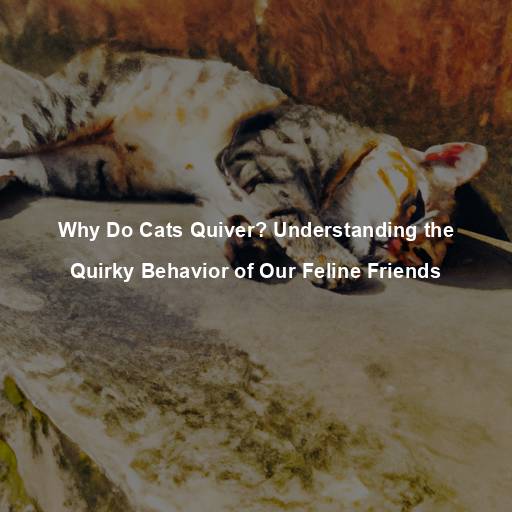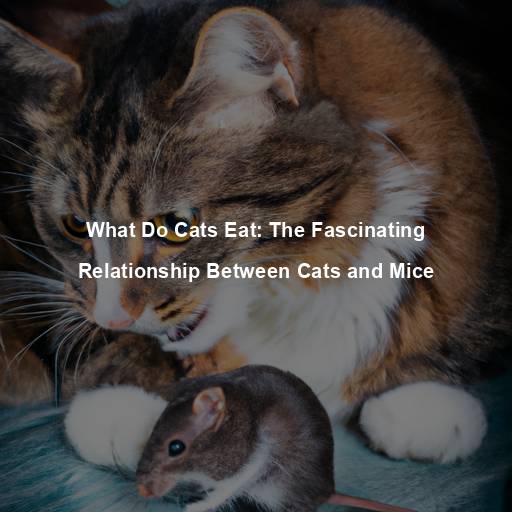Cats in Heat: Understanding Feline Reproduction and Behavior
Last Updated on July 23, 2023 by Evan
Contents
- 1 The Mysterious World of Feline Heat Cycles
- 2 Understanding the Cat Reproductive Cycle
- 3 Addressing the Challenges of Cats in Heat
- 4 The Myths and Misconceptions Surrounding Cats in Heat
- 5 Responsible Cat Ownership: Spaying and Neutering
- 6 Alternatives to Spaying and Neutering
- 7 The Importance of Education and Awareness
- 8 FAQs: Are Cats on Heat?
- 8.1 What does it mean when a cat is on heat?
- 8.2 At what age do cats go on heat?
- 8.3 How often do cats go on heat?
- 8.4 How long does a cat stay on heat?
- 8.5 What are the signs that a cat is on heat?
- 8.6 Can a cat get pregnant on her first heat?
- 8.7 Should I let my cat mate when she is on heat?
- 8.8 How can I calm down a cat in heat?
The Mysterious World of Feline Heat Cycles
What is Heat in Cats?
Cats, like many other mammals, go through reproductive cycles known as “heat” or “estrus”. Heat is a period of sexual receptivity and fertility in female cats, during which they are more likely to mate. Unlike humans, cats do not have a menstrual cycle, and their heat cycles are triggered by various factors such as daylight, temperature, and the presence of other cats.
Signs of a Cat in Heat
When our feline friends enter the enchanting realm of heat, they embark on a whirlwind journey of metamorphosis that arouses both curiosity and perplexity. During this transformative period, cats may undergo a captivating array of behavioral and physical changes that keep us on the edge of our seats. From heightened vocalizations to a restless demeanor, these unmistakable signs leave us marveling at the mysterious dance of nature that unfolds before our eyes.
- Vocalization: Female cats in heat are known to become quite vocal, yowling and meowing excessively to attract potential mates.
- Restlessness: Cats in heat may display increased agitation and restlessness. They may pace, roll on the floor, or rub against furniture and people.
- Increased Affection: Some cats become more affectionate during heat, seeking more attention and physical contact from their owners.
- Spraying: Female cats in heat may exhibit urine spraying behavior, marking their territory to attract males.
- Elevated Tail and Rear End Position: Cats in heat often hold their tail high and present their rear end in a mating posture.
- Rolling and Kneading: Some cats may engage in rolling and kneading motions, displaying mating behaviors even without a mate present.
Duration and Frequency of Heat Cycles
The fascinating world of feline biology takes us on a twisty journey through the enigmatic heat cycle of cats. Like a beguiling puzzle, the duration of this cycle dances within the realm of uncertainty, spanning from one to two weeks. Yet, it’s a captivating enigma, dependent on intricate variables such as breed, age, and the elusive tapestry of individual health. Mysterious as it may be, one thing is clear: female cats, if not spayed, may venture through multiple cycles throughout the year, especially in the alluring landscapes of mild climates where amorous encounters are ever-present.
Understanding the Cat Reproductive Cycle
The Phases of Feline Heat
The mysterious and enigmatic world of a feline’s heat cycle can be divided into four distinct phases, each as captivating and unpredictable as the next. From the initial flirtation with fertility to the ethereal allure of the peak mating season, a cat’s heat cycle is a complex dance of hormones and instincts that never ceases to amaze. As the feline enters the perplexing realm of estrus, her behavior takes on an alluring burst of energy, leaving both humans and fellow felines in awe of her mysterious ways. Finally, the curtain falls on this enigmatic performance as the cat reaches the post-estrus phase, leaving us in awe of the mysterious workings of the feline reproductive system.
- Proestrus: This is the beginning phase of the heat cycle and usually lasts for one to two days. During this time, the cat may display restlessness, increased affection, and vocalization. However, they are not yet ready to mate.
In a feline’s journey of reproduction, the enigmatic estrus phase takes center stage. This unpredictable period, lasting anywhere from three to seven days, renders cats at the height of their fertility and utmost openness to mating. From primal vocalizations to enticing postures, female cats in estrus showcase a bewitching mix of traits that both captivate and perplex.
Metestrus: Ah, the enigmatic phase that follows the fiery estrus stage in a cat’s reproductive journey. Like a whisper in the wind, this fleeting period lasts for a mere handful of days, leaving us captivated and perplexed. During this enigmatic phase, the feline body orchestrates a symphony of intricate preparations, lingering on the threshold of potential motherhood. However, if the dance of mating does not grace this beguiling creature, she may choose to either retreat back to proestrus, as if shyly stepping back, or gracefully embrace a period of anestrus, shrouded in mystery.
Have you ever wondered about the mysterious lulls in your cat’s reproductive rhythm? Enter anestrus, the enigmatic interlude between heat cycles where feline fertility hides away in the shadows. Lasting for varying stretches of time, from weeks to even months, anestrus acts as an enigmatic intermission for your cat’s reproductive system, evoking curiosity with its perplexing nature. During this captivating period, your cat’s reproductive system takes a break, leaving you to marvel at the intricacies of their complex biological dance.
The Role of Hormones
The mysterious world of feline biology unravels the enigmatic dance of hormones in regulating the intricate heat cycle of our cherished cats. A key player in this captivating hormonal symphony is estrogen, as it ebbs and flows through the enigmatic phases of a cat’s reproductive journey. During the perplexing heat phase, a female cat becomes a beacon, emitting alluring pheromones that bewitchingly lure male suitors from far and wide. The beguiling combination of these intoxicating scents and mesmerizing behavioral transformations serve as an enigmatic invitation to potential mates, igniting a primal dance of attraction.
Addressing the Challenges of Cats in Heat
The Importance of Spaying
Spaying (ovariohysterectomy) is a surgical procedure that removes a female cat’s ovaries and uterus, preventing her from going into heat and reproducing. Spaying not only helps control the cat population but also offers several health benefits, including a reduced risk of certain cancers and infections.
Dealing with a Cat in Heat
Dealing with a feline in the throes of the mysterious phenomenon known as “heat” can leave even the most seasoned cat caretaker perplexed and bursting with questions. Fear not, dear cat enthusiast, for we have compiled a compendium of tips to navigate this enigmatic period. From creating a stress-free environment to exploring the wonders of feline pheromones, these suggestions will help you bravely navigate the labyrinthine world of a cat in heat.
Creating a secure and protected environment for your feline companion is of utmost importance, especially during their heat cycle. By keeping them indoors, you can not only avoid the potential complications of unplanned pregnancies but also reduce the likelihood of any accidents or injuries that may arise from outdoor excursions during this delicate time.
Creating a serene atmosphere for your feline companion can do wonders in reducing their stress levels. Ensure your cat has access to quiet hiding spots where they can retreat and feel safe. Offering plush bedding will not only add a touch of comfort but also help ease their restlessness. Engage in gentle play sessions that capture their attention and divert their focus from any sources of anxiety.
-
Avoid Punishment: Understand that the behaviors displayed during heat are natural instincts. Avoid punishing or scolding your cat for vocalizing or exhibiting mating behaviors.
-
Consult with a Veterinarian: If your cat’s heat cycle becomes excessively long, frequent, or causes distress, consult with a veterinarian. They can provide advice and recommend potential solutions.
The Myths and Misconceptions Surrounding Cats in Heat
Myth: Female Cats Must Mate During Heat
Contrary to popular belief, female cats do not need to mate during heat to stay healthy. In fact, it is often recommended to have cats spayed to prevent unwanted pregnancies and potential health risks associated with mating.
Myth: Spaying a Cat Will Change Their Personality
When it comes to the spaying of cats, there seems to be a tangle of mixed opinions out there. Some claim that it may have a few behavioral consequences, like curbing territorial marking and aggression. However, the truth is that a cat’s innate personality remains largely intact even after the procedure. They still possess their own special quirks and individuality that make them who they are.
Myth: Female Cats Must Go Through a Heat Cycle Before Spaying
There seems to be a widely held belief that cats must reach a certain age before they can undergo spaying, but this is actually far from the truth. The reality is that cats can be spayed at any age, including before they experience their first heat. What’s even more intriguing is that opting for early spaying can bring a host of health advantages for our feline companions, not to mention the added perk of preventing any unexpected litters. So let’s debunk this misconception and ensure our cats are well-protected, regardless of their age or heat cycle status.
Overpopulation and Stray Cats
When cats are not spayed or neutered, the result can be a rapid increase in the cat population. Female cats in heat attract male cats from the surrounding area, leading to mating and subsequent pregnancies. This can contribute to the overpopulation of cats, which can strain local animal shelters and put a burden on communities.
Noise Pollution
Have you ever been perplexed by the sudden burst of noise coming from your feline friend? Well, let me shed some light on this curious phenomenon. When female cats are in heat, they can’t help but unleash a symphony of meows and yowls that echo through the night. This burst of vocalization can leave both owners and neighbors in a state of perplexity, as sleep becomes an elusive dream.
Aggression and Fighting
Unneutered male cats may become more aggressive during the mating season as they compete for the attention of female cats in heat. This can result in fights between male cats, leading to injuries and the potential spread of diseases. Neutering male cats can help reduce their aggression and minimize the risks associated with fighting.
Responsible Cat Ownership: Spaying and Neutering
The Benefits of Spaying and Neutering
Spaying and neutering are essential aspects of responsible cat ownership. These procedures offer numerous benefits for both cats and their owners, including:
- Preventing Unwanted Pregnancies: Spaying female cats eliminates the risk of unplanned pregnancies, reducing the number of stray and abandoned cats.
- Reducing the Risk of Certain Diseases: Spaying female cats before their first heat can significantly decrease their chances of developing mammary tumors and uterine infections.
- Controlling Behavioral Issues: Neutering male cats can help reduce aggressive behaviors, territorial marking, and roaming tendencies.
- Enhancing Overall Health: Spayed and neutered cats generally live longer and have a lower risk of certain reproductive system diseases.
The Spaying and Neutering Process
Spaying and neutering are routine surgical procedures performed by veterinarians. The surgeries involve removing the reproductive organs: the ovaries and uterus in female cats (spaying) and the testes in male cats (neutering). These procedures are typically done under general anesthesia, and most cats recover quickly with proper post-operative care.
When to Spay or Neuter Your Cat
The ideal age for spaying or neutering a cat can vary depending on factors such as breed, health, and the veterinarian’s recommendation. In general, cats can be spayed or neutered as early as 8 weeks of age. However, it is best to consult with a veterinarian to determine the most appropriate timing for your cat.
Alternatives to Spaying and Neutering
Non-Surgical Options
While spaying and neutering are considered the most effective and permanent methods of preventing unwanted pregnancies, there are alternative options available:
- Chemical Sterilization: Some medications can temporarily inhibit a cat’s fertility. However, these methods are not as reliable as surgical procedures and may require frequent administration.
- Hormonal Injections: Hormonal injections can prevent female cats from going into heat and mating. However, they may have side effects and are not suitable for all cats.
It is important to note that these alternatives are not as widely recommended as spaying and neutering due to their limitations and potential risks.
The Importance of Education and Awareness
Promoting Responsible Pet Ownership
When it comes to responsible pet ownership and managing the cat population, education is paramount. By shedding light on the importance of spaying and neutering, as well as the potential repercussions of neglecting these measures, we can motivate individuals to take a proactive stance. With increased awareness, we can tackle the issue head-on and promote a more responsible approach to cat care.
Financial Assistance Programs
Amidst the daunting financial hurdles that pet owners may encounter, there is a silver lining in the form of various organizations providing much-needed respite. These benevolent programs extend their helping hands by offering cost-effective and even subsidized spaying and neutering services. By doing so, they not only strive to break through the barriers obstructing responsible pet ownership but also ensure that our furry friends receive the care they deserve without breaking the bank.
Community Initiatives
When it comes to the topic of cats in heat, communities can truly make a splash in the deep ocean of challenges. By orchestrating these magnificent spay/neuter clinics, they can send ripples of change cascading through the feline world. Raising awareness like rays of sunshine cutting through the fog, communities can illuminate the importance of responsible pet ownership, ultimately guiding lost souls back into the loving arms of care. Through their collective efforts, these communities have the opportunity to paint a canvas of compassion, reducing the number of stray cats and creating a masterpiece of improved feline welfare.
FAQs: Are Cats on Heat?
What does it mean when a cat is on heat?
The captivating allure of a feline’s heat is an enigmatic rite of passage, an intricate dance of nature’s calling. In this ethereal phase of a female cat’s existence, her reproductive cycle, known as estrus, takes center stage. It is during this beguiling period that she unveils an array of transformative physical and behavioral metamorphoses heralding her primed fertility and innate desire to procreate.
At what age do cats go on heat?
As feline adolescents enter the complex realm of puberty, their bodies embark on a journey that unveils the mystifying phenomenon known as heat. With an entrancing blend of variation and enigma, the timing of this beguiling event can baffle even the most seasoned feline aficionados. While some kittens may initiate this enigmatic phase as early as four months, others might obediently wait until their first anniversary, leaving us marveling at the bewitching diversity that exists within the feline kingdom. So, brace yourself for the unpredictable, as each whiskered wonder unfurls their tale of maturation at their own bewitching pace.
How often do cats go on heat?
When it comes to our feline friends and their mysterious ways, one thing that never ceases to perplex us is the enigmatic realm of cat heat cycles. It’s no secret that these sly creatures dance to their own tune, but when exactly do they hit the dancefloor? Well, my friend, that’s where things get wonderfully bursty and intriguing. Cats, being the independent beings that they are, can find themselves in the thralls of heat not just once, but multiple times a year, leaving us humans scratching our heads in bewilderment. From the inviting embrace of spring to the lingering warmth of early fall, one thing is for certain – our furry companions sure know how to keep us on our toes. Yet, just like every whiskered wonder, each cat boasts its own individual hormonal patterns, resulting in a mesmerizing array of heat cycle frequencies and durations. And let’s not forget about the environmental factors that come into play, adding an extra layer of enigma to the mix. So, buckle up and get ready to dive into the captivating world of cat heat cycles, a splendid tapestry of variation and intrigue that leaves us in a perpetual state of awe.
How long does a cat stay on heat?
The duration of a cat’s heat cycle can vary, but it typically lasts between four to ten days. During this time, the cat’s behavior and physical signs of heat will reach their peak, and she may attract male cats with vocalizations and increased affectionate behavior.
What are the signs that a cat is on heat?
As feline hormones tango within, a mesmerizing dance of perplexity unfolds. A symphony of behaviors reveals a cat’s saucy secret, her heat-induced rhapsody. From a melodious chorus of new-found vocal prowess to a restless ballet upon the floor, her mysterious allure bewitches both objects and beings alike. As affection blossoms, hindquarters ascend and her grand finale, a symphony of frequent urination, marks the climax of her enigmatic performance.
Can a cat get pregnant on her first heat?
Yes, a cat can become pregnant during her first heat cycle. Once a cat reaches sexual maturity and goes into heat, she is capable of mating and conceiving. Therefore, it is essential to keep intact female cats indoors or under close supervision during their heat cycles if breeding is not desired.
Should I let my cat mate when she is on heat?
Deciding whether to let your feline companion indulge in romantic rendezvous amidst her fiery heat calls for some contemplation and a dash of prudence. If your intention is not to welcome a fluffy bundle of joy or if your furry friend lacks the credentials for the feline fashion show, it is generally wise to deter any amorous affairs. Allowing incessant breeding merely adds fuel to the already blazing overpopulation crisis and skyrockets the count of stray kitties roaming the streets. Hence, seeking counsel from a seasoned veterinarian to explore optimal alternatives, such as spaying your feline sweetheart to avert unforeseen pregnancies and safeguard her health, comes highly recommended.
How can I calm down a cat in heat?
When a cat is in heat, her behavior and restlessness may be challenging to manage. Providing a calm and comfortable environment for your cat can help. You can try increasing their physical and mental stimulation with interactive play sessions, providing hiding spots or cozy areas, and creating a routine to establish a sense of security. Additionally, consulting with a veterinarian about possible hormonal or behavioral interventions, such as medications or pheromone-based products, may be beneficial in managing your cat’s heat cycle.






